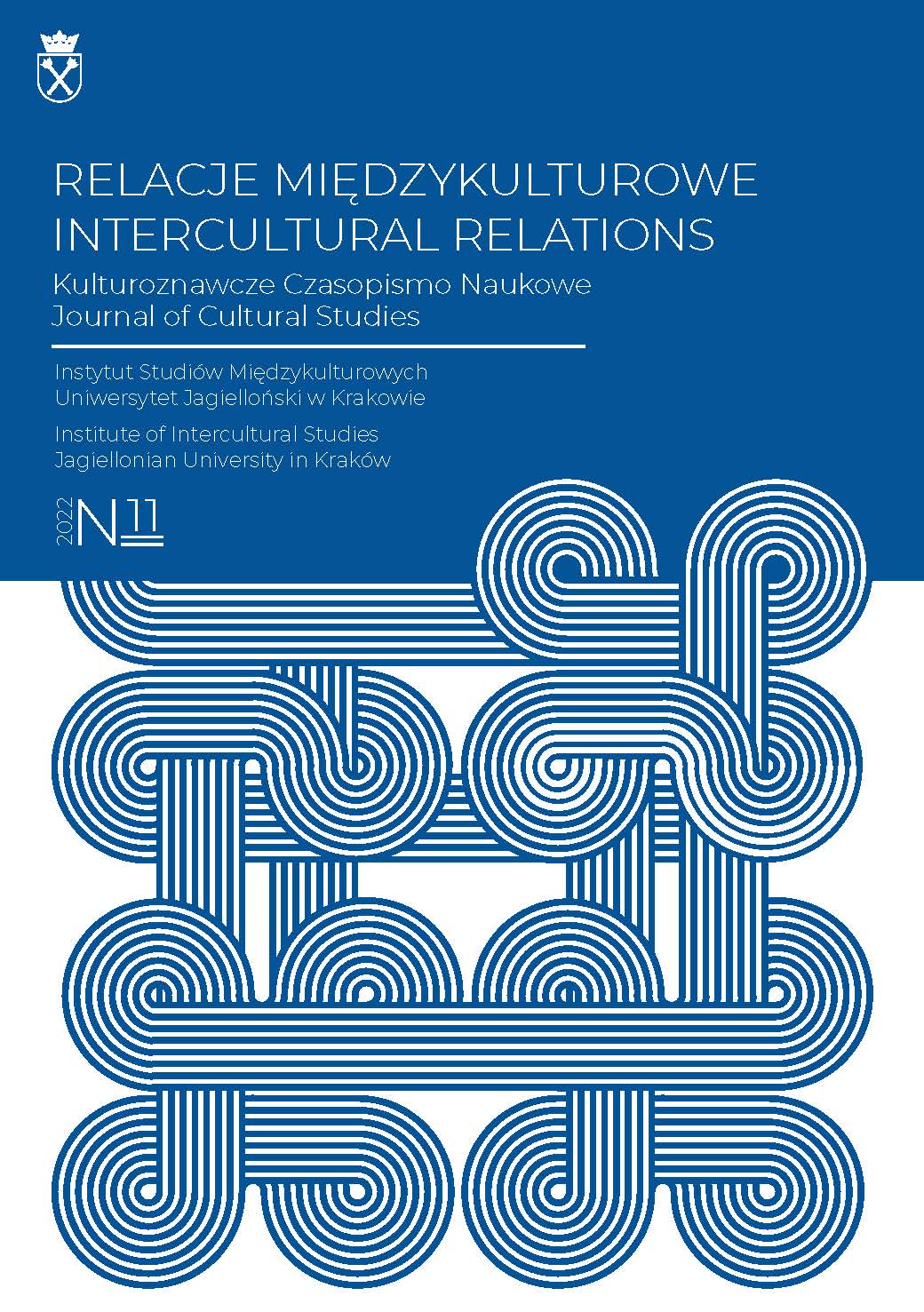Emocje a interpersonalna komunikacja międzykulturowa
DOI:
https://doi.org/10.12797/RM.01.2022.11.02Keywords:
emotions, cross-cultural communication, intercultural competencesAbstract
EMOTIONS AND INTERPERSONAL CROSS-CULTURAL COMMUNICATION
Understanding one’s own emotional states as well as the emotional states present in the partner of an intercultural interaction seems to be something essential for the success of the encounter. However, emotions remain ephemeral, eluding rational discernment and control, as well as there is a lack of scientific agreement about their nature. Emotional competence, including the regulation of emotions during intercultural interaction, seems especially important from the point of view of reducing negative consequences of such interactions. It’s also a basis for the adaptation process, but also an element of a person’s psychological development.
References
Bennett, M., Bennett, J. 2004. Developing Intercultural Sensitivity: An Integrative Approach to Global and Domestic Diversity. W: Landis, D., Bennett, J., Bennett, M. (red.), DOI: https://doi.org/10.4135/9781452231129.n6
The Handbook of Intercultural Training ( s. 1 47–165). T housand O aks: S age, h ttps://doi.org/10.4135/9781452231129.N6.
Bergelson, M. 2012. Russian Cultural Values and Workplace Communication Patterns. W: Samovar, L. A., Porter, R. E., McDaniel, E. R. (red.), Intercultural Communication: A Reader (13 wyd.), (s. 189–197). Boston: Wadsworth, Cengage Learning.
Boski, P. 2022. Kulturowe ramy zachowań społecznych (2 wyd.), Warszawa: Wydawnictwo Naukowe PWN, https://doi.org/10.53271/2022.005.
Bukowski, M., Winiewski, M. 2011. Emocje międzygrupowe a stereotypy i zagrożenia społeczne: co jest przyczyną, a co skutkiem uprzedzeń. W: Kofta, M., Bilewicz, M. (red.), Wobec obcych. Zagrożenia psychologiczne a stosunki międzygrupowe (s. 4 0–59). Warszawa: Wydawnictwo Naukowe PWN.
Ekman, P. 1992. An Argument for Basic Emotions, „Cognition and Emotion”, 6(3/4), 169–200, https://doi.org/10.1080/02699939208411068. DOI: https://doi.org/10.1080/02699939208411068
Ekman, P. 1999. Basic Emotions. W: Dalgleish, T., Power, M. (red.), Handbook of Cognition and Emotion (s. 45–60). Chichester: John Wiley & Sons, https://doi.org/10.1002/0470013494.ch3. DOI: https://doi.org/10.1002/0470013494.ch3
Furnham, A. 2012. Emotional Intelligence. W: Di Fabio, A. (red.), Emotional Intelligence – New Perspectives and Applications (s. 3–28). Rijeka: InTech, https://doi.org/10.5772/31079. DOI: https://doi.org/10.5772/31079
Golka, M. 2016. Komunikowanie międzykulturowe. Przypomnienie głównych tez, „Multicultural Studies”, 1, 41–52, https://doi.org/10.23734/mcs.2016.1.041.052.
Goodwin, R. 1999. Personal Relationships Across Cultures, London, New York: Routledge, https://doi.org/10.4324/9780203434161. DOI: https://doi.org/10.4324/9780203434161
Guntersdorfer, I., Golubeva, I. 2018. Emotional Intelligence and Intercultural Competence: Theoretical Questions and Pedagogical Possibilities, „Intercultural Communication Education”, 1(2), 54–63, https://doi.org/10.29140/ice.v1n2.60. DOI: https://doi.org/10.29140/ice.v1n2.60
Hwang, H. C., Matsumoto, D. 2017. Emotion Display and Expression. W: Chen, L. (red.), Intercultural Communication (s. 219–238). Boston, Berlin: De Gruyter Mouton, https://doi.org/10.1515/9781501500060-010. DOI: https://doi.org/10.1515/9781501500060-010
Izard, C. E. 1983. Emotions in Personality and Culture, „Ethos”, 11(4), 305–312, https://doi.org/10.1525/eth.1983.11.4.02a00070. DOI: https://doi.org/10.1525/eth.1983.11.4.02a00070
Kofta, M., Bilewicz, M. 2011. Wprowadzenie. Zagrożenie psychologiczne a stosunki międzygrupowe: nowe idee. W: Kofta, M., Bilewicz, M. (red.), Wobec obcych. Zagrożenia psychologiczne a stosunki międzygrupowe (s. 7–17). Warszawa: Wydawnictwo Naukowe PWN.
Korporowicz, L. 2009. Komunikacja międzykulturowa jako transgresja. W: Paleczny, T., Banaś, M. (red.), Dialog na pograniczach kultur i cywilizacji (s. 75–84). Kraków: Wydawnictwo Uniwersytetu Jagiellońskiego.
Kumar, R., Sethi, A. K. 2012. Communicating with Indians. W: Samovar, L. A., Porter, R. E., McDaniel, E. R. (red.), Intercultural Communication: A Reader (13 wyd.) (s. 170–178). Boston: Wadsworth, Cengage Learning.
Leung, K., Ang, S., Tan, M. L. 2014. Intercultural Competence, „Annual Review of Organizational Psychology and Organizational Behavior”, 1, 489–519. DOI: https://doi.org/10.1146/annurev-orgpsych-031413-091229
McKone, E., Dawel, A., Robbins, R. A., Shou, Y., Chen, N. Crookes, K. 2021. Why the Other-race Effect Matters: Poor Recognition of Other-race Faces Impacts Everyday Social Interactions, „British Journal of Psychology”, https://doi.org/10.1111/bjop.12508. DOI: https://doi.org/10.1111/bjop.12508
Malinowska, J. K. 2016. Cultural Neuroscience and the Category of Race: The Case of the Other-race Effect, „Synthese”, 193, 3865–3887, https://doi.org/10.1007/s11229-016-1108-y. DOI: https://doi.org/10.1007/s11229-016-1108-y
Matsumoto, D., Takeuchi, S. 1998. Emotions and Intercultural Communication, „Intercultural Communication Research”, 11, 1–32.
Matsumoto, D., Yoo, S. H., LeRoux, J. A. 2007. Emotion and Intercultural Adjustment. W: Kotthoff, H., Spencer-Oatey, H. (red.), Handbook of Intercultural Communication, vol. 7 (s. 77–97). Berlin, New York: Mouton de Gruyter.
Martin, J. N., Nakayama, Th. K. 2010. Intercultural Communication in Contexts (5 wyd.), Boston: McGraw-Hill.
Maruszewski, T., Ścigała, E. 1995. Poznawcza reprezentacja emocji, „Przegląd psychologiczny”, 38(3/4), 245–278.
Mayer, J. D., Salovey, P., Caruso, D. R. 2004. Emotional Intelligence: Theory, Findings, and Implications, „Psychological Inquiry”, 15(3), 197–215, https://doi.org/10.1207/s15327965pli1503_02. DOI: https://doi.org/10.1207/s15327965pli1503_02
Mesquita, B., Boiger, M., De Leersnyder, J. 2016. The Cultural Construction of Emotions, „Current Opinion in Psychology”, 8, 31–36, https://doi.org/10.1016/j.copsyc.2015.09.015. DOI: https://doi.org/10.1016/j.copsyc.2015.09.015
Mesquita, B., Frijda, N. H. 1992. Cultural Variations in Emotions: A Review, „Psychological Bulletin”, 112(2), 179–204, https://doi.org/10.1037/0033-2909.112.2.179. DOI: https://doi.org/10.1037/0033-2909.112.2.179
Miike, Y. 2012. “Harmony Without Uniformity”: An Asiacentric Worldview and Its Communicative Implications. W: Samovar, L. A., Porter, R. E., McDaniel, E. R. (red.) Intercultural Communication: A Reader (13 wyd.) (s. 65–80). Boston: Wadsworth, Cengage Learning.
Oberg, K. 1960. Cultural Shock: Adjustment to New Cultural Environments, „Practical Anthropology”, 7, 177–182, https://doi.org/10.1177/009182966000700405. DOI: https://doi.org/10.1177/009182966000700405
Samovar, L. A., Porter, R. E., McDaniel, E. R. 2010. Communication Between Cultures (7 wyd.), Boston: Wadsworth, Cengage Learning.
ten Thije, J. D. 2020. What Is Intercultural Communication?. W: Rings, G., Rasinger, S. (red.) The Cambridge Handbook of Intercultural Communication (s. 35–55). Cambridge: Cambridge University Press, https://doi.org/10.1017/9781108555067.004. DOI: https://doi.org/10.1017/9781108555067.004
Tomasello, M. 2008. Origins of Human Communication, Cambridge, London: The MIT Press. DOI: https://doi.org/10.7551/mitpress/7551.001.0001
Triandis, H. C. 2006. Cultural Intelligence in Organizations, „Group & Organization Management”, 31(1), 20–26, https://doi.org/10.1177/1059601105275253. DOI: https://doi.org/10.1177/1059601105275253
Wierzbicka, A. 1999. Emotions Across Languages and Cultures: Diversity and Universals, Paris: Cambridge University Press, https://doi.org/10.1017/CBO9780511521256. DOI: https://doi.org/10.1017/CBO9780511521256
Downloads
Published
How to Cite
Issue
Section
License

This work is licensed under a Creative Commons Attribution-NonCommercial-NoDerivatives 4.0 International License.






